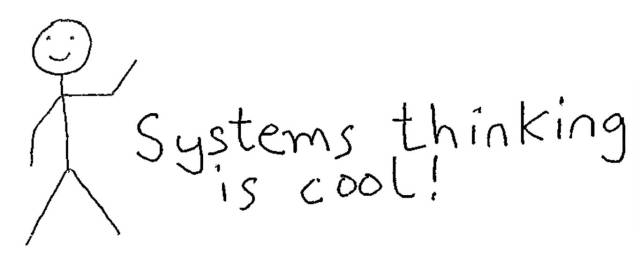“What is systems thinking?”
This is a question I’ve heard quite a lot recently.
So, with the assistance of our little friend Stick Child (yes he’s back by popular demand!) let’s take a look at the subject in very straightforward terms.
By happy coincidence, Stick Child’s latest piece of homework was to find out about systems thinking, and fortunately his Daddy knows a bit about the subject, so the pair of them sat down together and came up with a simple guide. Here are some excerpts, below:

Some Systems Thinking Principles
 Firstly, Stick Child learnt that there are lots of different strains of ‘systems thinking’. Some of them are very complex and theoretical, but Stick Child and his Daddy particularly like Deming‘s stuff, as it’s pretty simple and easy to apply in real life.
Firstly, Stick Child learnt that there are lots of different strains of ‘systems thinking’. Some of them are very complex and theoretical, but Stick Child and his Daddy particularly like Deming‘s stuff, as it’s pretty simple and easy to apply in real life.
Deming described a system as, “A network of interdependent components that work together to try and accomplish an aim”. The important thing here is that these interdependent components must cooperate, otherwise everyone looks after their own interests and the system breaks down. This means that the customer or service user loses out, which is bad.
Therefore, it is really important that we are absolutely clear about the aim of the system; for example, a hospital might seek to ‘help people get better’, whilst the police try to ‘prevent crime and catch offenders’. In fact, some systems can have lots of aims – in the case of the police, they do lots of things that have nothing to do with crime; these things are also very important.
Stick Child learnt that there is no single ‘right’ interpretation of systems thinking, because there is lots of common ground between different systems approaches.
Measurement
 Stick Child discovered that measurement is really important in systems thinking. He learnt that we need to measure things that are happening within the system to understand how it is performing, but that they must be the right measures, measured in the right way. (He found this out from a blog by someone called InspGuilfoyle). Stick Child knows that one of the best ways to measure things is by using control charts.
Stick Child discovered that measurement is really important in systems thinking. He learnt that we need to measure things that are happening within the system to understand how it is performing, but that they must be the right measures, measured in the right way. (He found this out from a blog by someone called InspGuilfoyle). Stick Child knows that one of the best ways to measure things is by using control charts.
Remember this one?

Stick Child also found out that some people can’t tell the difference between ‘targets’ and ‘measures’ and this prevents them from being able to understand some really important stuff about how systems work. He wonders if there’s a special medicine they could take that would help their brains.
Bad Performance Management Practices
Stick Child learnt that well-meaning people sometimes use really bad ways of trying to measure things, like binary comparisons. He also found out numerical targets and league tables make people put effort into outdoing each other instead of concentrating on the real aim of the system. Sometimes they even cheat and tell lies. Stick Child’s Daddy says that this is because numerical targets are arbitrary and cause dysfunctional behaviour.

Waste
Stick Child discovered that waste is activity that slows the system down and doesn’t help to achieve its aim. There are many types of waste – failure demand and rework are types of waste that occur because something wasn’t done properly the first time round. Waste also occurs when demand that shouldn’t be there in the first place enters the system, or when people within the system invent work for others to do, like writing lots of plans, or making them go to meetings where nothing useful occurs.
 Stick Child thinks it would be better to put this effort into actually doing the work, rather than writing about it or talking about it. He does, however, accept that this might be a radical concept for some people.
Stick Child thinks it would be better to put this effort into actually doing the work, rather than writing about it or talking about it. He does, however, accept that this might be a radical concept for some people.
Conclusion
Stick Child came to realise that the thinking part of systems thinking is really important. He learnt that management thinking needs to change in order for systems-based approaches to succeed. He understands that if we keep doing the same things we will keep getting the same results. That’s why we need to remove the bad things that hurt the system, then redesign it so that all the different bits work together to achieve its aim, whether this be helping people to get better when they are poorly, or catching baddies.
If Stick Child understands this, so can you.



Reblogged this on RetiredAndAngry and commented:
A cynical attempt to make my blog look more respectable.
However, I do like Stick Child and his Dad so go on, give it a read
Reblogged this on Primary Blogging.
Pingback: Stick Child’s Guide to Systems Thinking | Gauteng Veterinary Services